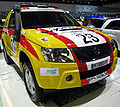2007 Suzuki Grand Vitara Owner's Manual - Page 168
2007 Suzuki Grand Vitara Manual
Page 168 highlights
INSPECTION AND MAINTENANCE 5) If the air pressure is too low, fill the tire with air at a service station until it reaches the recommended pressure. 6) Make sure all tires have the same air pressure (unless the owner's manual indicates otherwise). Tire Inspection Inspect your vehicle's tires at least once a month by performing the following checks: 1) Measure the air pressure with a tire gauge. Adjust the pressure if necessary. Remember to check the spare tire, too. Refer to the "Measuring Air Pressure" section. damage should be replaced. If any tires show abnormal wear, have them inspected by your SUZUKI dealer. WARNING Hitting curbs and running over rocks can damage tires and affect wheel alignment. Be sure to have tires and wheel alignment checked periodically by your SUZUKI dealer. 4) Check for loose wheel nuts. 5) Check that there are no nails, stones or other objects sticking into the tires. WARNING • Air pressures should be checked when the tires are cold or you may get inaccurate readings. • Check the inflation pressure from time to time while inflating the tire gradually, until the specified pressure is obtained. • Never underinflate or overinflate the tires. Underinflation can cause unusual handling characteristics or can cause the rim to slip on the tire bead, resulting in an accident or damage to the tire or rim. Underinflation can also cause tires to overheat, leading to tire failure. Overinflation can cause the tire to burst, resulting in personal injury. Overinflation can also cause unusual handling characteristics which may result in an accident. WARNING Your SUZUKI is equipped with tires which are all the same type and size. This is important to ensure proper steering and handling of the vehicle. Never mix tires of different size or type on the four wheels of your vehicle. The size and type of tires used should be only those approved by SUZUKI Motor Corporation as standard or optional equipment for your vehicle. 54G136 (1) Tread wear indicator (2) Indicator location mark 2) Check that the depth of the tread groove is more than 1.6 mm (0.06 in.). To help you check this, the tires have molded-in tread wear indicators in the grooves. When the indicators appear on the tread surface, the remaining depth of the tread is 1.6 mm (0.06 in.) or less and the tire should be replaced. 3) Check for abnormal wear, cracks and damage. Any tires with cracks or other 9-27
















